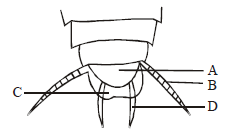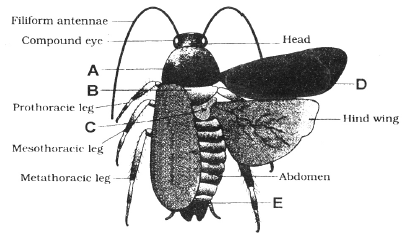Please refer to Structural Organisation in Animals Class 11 Biology Important Questions with solutions provided below. These questions and answers have been provided for Class 11 Biology based on the latest syllabus and examination guidelines issued by CBSE, NCERT, and KVS. Students should learn these problem solutions as it will help them to gain more marks in examinations. We have provided Important Questions for Class 11 Biology for all chapters in your book. These Board exam questions have been designed by expert teachers of Standard 11.
Class 11 Biology Important Questions Structural Organisation in Animals
Objective Questions
Question. The kind of epithelium which forms the inner walls of blood vessels is
(a) cuboidal epithelium
(b) columnar epithelium
(c) ciliated columnar epithelium
(d) squamous epithelium
Answer
D
Question. Mast cells are associated with
(a) exocrine glands
(b) endocrine glands
(c) areolar connective tissue
(d) neural tissue
Answer
C
Question. Compound squamous epithelium is found in
(a) stomach
(b) intestine
(c) trachea
(d) pharynx
Answer
D
Question. Which of the following type of cell junction is not found in animal tissues ?
(a) Adhering junction
(b) Tight junction
(c) Gap junction
(d) Plasmodesmata
Answer
D
Question. The chondrocytes of connective tissue are
(a) fibre secreting cells
(b) bone forming cells
(c) cartilage cells
(d) bone eating cells
Answer
C
Question. Tendons and ligaments are the examples of
(a) areolar connective tissue
(b) adipose tissue
(c) dense regular connective tissue
(d) loose connective tissue
Answer
C
Question. In all connective tissues, except which of the following, the cells secrete fibres of collagen or elastin protein ?
(a) Bone
(b) Cartilage
(c) Areolar connective tissue
(d) Fluid connective tissue
Answer
D
Question. The supportive skeletal structures in the human external ears and in the nose tip are examples of
(a) ligament
(b) areolar tissue
(c) bone
(d) cartilage
Answer
D
Question. Intercalated discs are the communication junctions between the cells of
(a) cardiac muscles
(b) striped muscles
(c) adipose tissue
(d) nerve and striated muscles
Answer
A
Question. Neuroglia are
(a) excitable cells of neural tissue.
(b) supporting and non-excitable cells of neural tissue.
(c) two to three times in volume of neural tissue.
(d) protective and excitable cells of neural tissue.
Answer
B
Statement Type Questions
Question. Which statement regarding anal cerci and anal style incockroach is correct?
(a) Anal cerci are absent but anal styles are present in male.
(b) Anal cerci are absent and anal styles are present in female.
(c) Anal styles are absent and anal cerci are present in male.
(d) Anal styles are absent and anal cerci are present in female.
Answer
D
Question. Which of the following statement is incorrect regarding cuboidal epithelium ?
(a) It is an epithelial tissue.
(b) It is composed of a single layer of cube-like cells.
(c) They are found in the walls of blood vessels and air sacs of lungs.
(d) Secretion and absorption are the main functions of these tissue.
Answer
C
Question. Which of the following statement(s) is/are correct about muscle tissue ?
(a) Each muscle is made of many long, cylindrical fibres arranged in parallel arrays.
(b) Muscle fibres contract (shorten) in response to stimulation, then relax (lengthen) and return to their
uncontracted state in a coordinated fashion.
(c) Muscles play an active role in all movements of the body.
(d) All of the above
Answer
D
Question. Which of the following statement is correct regarding Female reproductive system of earthworm ?
(a) It consists of two large ovaries, lying laterally in the 6th – 7th abdominal segments.
(b) Each ovary is formed of a group of five ovarian tubules or ovarioles, containing a chain of developing ova.
(c) A pair of spermatheca is present in the 5th segment which opens into the genital chamber.
(d) None of the above
Answer
D
Question. Consider the following statements regarding cockroach and mark the correct option.
(i) Head is formed by the fusion of 6-segments.
(ii) Mouth parts are biting and chewing type.
(iii) Crop is the part of mid gut.
(a) Only (ii) is correct
(b) (ii) and (iii) are correct
(c) (i) and (ii) are correct
(d) Only (iii) is correct
Answer
C
Assertion/Reason Type Questions
In the following questions, a statement of Assertion is followed by a statement of Reason.
(a) If both Assertion and Reason are true and the Reason is the correct explanation of the Assertion.
(b) If both Assertion and Reason are true but the Reason is not the correct explanation of the Assertion.
(c) If Assertion is true but Reason is false.
(d) If both Assertion and Reason are false.
Question. Assertion: Typhlosole increases the effective area of absorption in the intestine.
Reason: Typhlosole, present in the intestine, is the characteristic feature of cockroach.
Answer
D
Question. Assertion : Connective tissues are most aboundant and help in linking and supporting other tissues organ of the body.
Reason : In all connective tissues except blood the cells secrete collagen or elastin.
Answer
B
Question. Assertion : Numerous minute pores called nephridio pores open on the surface of the body of earthworm.
Reason : In each body segment, there are rows of S-Shaped setae present.
Answer
C
Question. Assertion : Intercalated discs are important regions of cardiac muscle cells.
Reason : Intercalated discs function as boosters for muscle contraction waves.
Answer
A
Critical Thinking Type Questions
Question. The blood of cockroach contains no respiratory pigment. It means that
(a) cockroach does not respire.
(b) respiration is anaerobic.
(c) oxygen goes directly into tissues by diffusion.
(d) oxygen goes directly into tissues by intracellular capillary system.
Answer
D
Question. What will happen if ligaments are cut or broken?
(a) No movements at joints.
(b) Bones will become fixed.
(c) Bones will become unfixed.
(d) Bone will move freely at joints.
Answer
C
Question. In cockroach head can move in all directions due to
(a) absence of neck.
(b) fusion of all 6 segments of head.
(c) flexible neck.
(d) head is small and light weight.
Answer
C
Question. Choose the correct sequence of alimentary canal of Cockroach
(a) Gizzard → Crop → Malphigian tubules → Hepatic caeca → Rectum.
(b) Gizzard → Hepatic caeca → Crop → Rectum → Malphigian tubules.
(c) Crop → Gizzard → Hepatic caeca → Malphigian tubules → Rectum.
(d) Crop → Hepatic caeca → Gizzard → Rectum → Malphigian tubules.
Answer
C
Question. The secretions of endocrine glands are released directly
(a) into the skin surface
(b) into the blood stream
(c) into a gland duct
(d) into the brain tissue
Answer
B
Question. When cardiac muscle cells are damaged by a heart attack, they are usually replaced by
(a) connective tissue cells
(b) new smooth muscle cells
(c) new cardiac muscle cells
(d) epithelial cells
Answer
A
Question. Which of the following is involved in the production of new blood cells ?
(a) Adipose cell
(b) Bone marrow
(c) Liver
(d) Matrix
Answer
B
Diagram Type Questions
Question. The diagram given below represents the reproductive organ of male cockroach. Choose the correct labelling of the part of marked as A, B, C and D.

(a) A – 8th sternum, B – Anal cercus, C – 10th tergum, D – Anal style
(b) A – 10th tergum, B – Anal cercus, C – Anal style, D – 8th sternum
(c) A – Anal style, B – Anal cercus, C – 10th tergum, D- 8th sternum
(d) A – Anal cercus, B – 8th sternum, C – 10th tergum, D – Anal style.
Answer
A
Question. Identify figures-I and II.

| Figure I | Figure II |
| (a) Dense regular connective tissue, | Dense irregular connective tissue |
| (b) Loose irregular connective tissue, | Loose regular connective tissue |
| (c) Adipose tissue, | Specialized connective tissue |
| (d) Connective tissue proper | Areolar tissue |
Answer
A
Question. The following figure shows the extarnal features of cockroach with few structures labelled as A, B, C, D, and E. Identify A to E .

(a) A- Mesothorax, B-Pronotum, C-Metathorax, D-Tegmina, E-Anal style
(b) A- Pronotum, B-Metathorax, C-Mesothorax, D-Tegmina, E-Sterna
(c) A- Pronotum, B-Mesothorax, C-Metathorax, D-Tegmina, E-Anal cerci
(d) A- Pronotum, B-Mesothorax, C-Metathorax, D-Tegmina, E-Anal style
Answer
C
Question. The given figure shows the digestive system of cockroach with few structures marked as A, B, C and D. Identify structures A to D.

(a) A-Gizzard, B-Crop, C-Hepatic caecae, D-Malpighian tubules
(b) A-Crop, B-Gizzard, C-Hepatic caecae, D-Malpighian tubules
(c) A- Crop, B-Gizzard, C-Malpighian tubules, D-Hepatic caecae
(d) A- Gizzard, B-Crop, C-Malpighian tubules, D-Hepatic caecae
Answer
B
Question. Figure given below shows reproductive system of female cockroach. The correct labellings indicated by alphabets (A, B & C) are respectively

(a) A-Spermatheca, B-Collaterial glands, C-Gonapophyses
(b) A-Phallic gland, B-Collaterial glands, C-Gonapophyses
(c) A-Spermatheca, B-Seminal vesicle, C-Gonapophyses
(d) A-Spermatheca, B-Collateral glands, C-Tegmina
Answer
A


